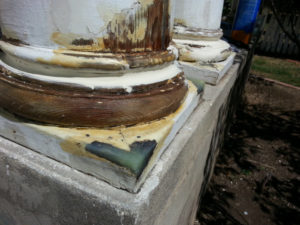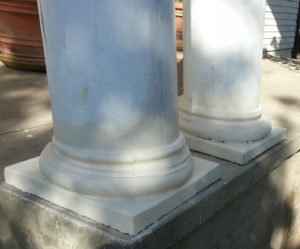Rotted Wood and Termite Repair
Refinish Your Wood Furniture and Decks
February 16, 2013Scripps Carriage House
April 30, 2013For years and even before I was a painting contractor I was aware of polyester fillers…the main one being Bondo. I used it to repair all the dents and dings in my extended ego (read car) in high school and college. When I started painting, of course I began using it and other brands of similar formulations on homes and came to find that what is good for thin repairs on a car may not be good for a thin repair on the siding of a ship-lap sided home. After a few months in the sun, I was back removing the remainder of what the sun had not de-laminated for me. The problem was that polyester filler is not formulated to do two things very well: adhere nor flex with wood substrates…lesson learned. I do keep polyester filler in the truck though, as it does work well for effective interior repairs to heavily damaged lock-sets and dead-bolts that have been blown out. It dries super-fast especially so because you can “goose” it with extra catalyst. On the other hand there is epoxy which you cannot “goose” with extra catalyst or you will really screw it up. Epoxies are each uniquely formulated to a specific dry time and thickness/viscosity as well as dry flexibility properties and adhesion and they do adhere! Most of these are overnight dry which is why painters who don’t give a hoot for quality of the repair rely too heavily on Bondo so it will cure in 2 minutes and they can get home to beer and Oprah while the repair fails as soon as the check clears. Various epoxies are made for craftsmen and proper wood repairs should be in your tool box. Here are a few I always have on hand:
Removing Rotted Wood
Now with any repair: the wet, feathery, lignin-free wood needs to be gotten rid of. Like a dentist, you have to use whatever tool: a drill, chisel, 5-1 and get that bad wood out. I then drill pilot holes all around the repair and in the sides and base at an angle and soak the surrounding wood with consolidator (see Smith’s Epoxy below) which is often sold by the epoxy manufacturer and can be a very thin epoxy itself that plasticizes the wood or an very thin acrylic that chases water and impregnates with hardening in the wood. Note: after the repair is totally complete I will go just outside it and drill ¼” holes where water might get in again and insert boric acid pellets so that they will disperse into the wood and prevent rot if water should ever enter. Also use a polyurethane caulk like Vulkem (oil based) at upper facing seams that could open up in the future…sure it takes a few days to dry and you cannot paint it “in minutes” but aren’t “time saving” products like cheap caulk that you can “paint in minutes” what cause premature failure in the end? Shoot…if you are going to be using a $45 tube or can of epoxy…sell yourself, do it right, sleep at night and be a craftsman
- Flex-Tech: this product comes in a double tube that is pumped out of a double barrel caulk gun. Buy the gun with your first order…it is worth its weight in gold as it assures you get the exact balance of resin and hardener. This product comes out like thick peanut butter and spreads in a “Jiffy” but will hold its shape in the deepest repair. It is easy to tool with putty knives in large holes and is better than the others for old rusty nail holes that you have set deep in siding and do not want to rise up and show their ugly old heads again!
- There are many epoxy fillers available that are wood colored, two component and composed of epoxy and light weight micro-spheres. PC-Woodie, System Three and Abatron are three of this type. Use surgical gloves and mix the two dough components together and push them into the repair. A neat trick is to use white vinegar to wet your putty knife and smooth the repair for minimal sanding.
- Smith Co. makes a watery epoxy that I buy in two gallon kits of equal parts hardener and resin. This stuff soaks into raw wood and hardens. This key feature can and years to the durability of your paint jobs. Take, for instance a new raw wood panel door. We have all experienced the rot at the hinge side rail and stile joint after a few years even after priming and painting properly from the start. The problem nowadays is that with all those joints, compounded by the core being lesser quality wood and the fact that most doors fool both carpenter and owner with a thin fancy veneer that will pull away from the joint; nothing is going to keep that door from pulling apart and letting water and rot in unless you pre-treat it. With Smith’s epoxy, mix up a good pint to a quart and brush on a coat to the top and bottom of the door (let it soak in and do it again especially on end grain), behind hinges and all cut outs for hardware and especially at lower rails and stiles…I even go further and soak the whole door and then caulk the open gaps on the top and bottom of the doors with Vulkem. This door has been prepared properly!
Hope these tips and products will help you




